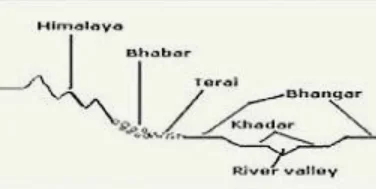The Northern Plains of India, formed by the convergence of the mighty Indus, Ganga, and Brahmaputra rivers, are a vast expanse of fertile land. Stretching across North India, from Punjab to West Bengal and Assam, these plains are known for their rich alluvial soil and unique geographical features.
Alluvial Northern Plains of India
- Formation: The alluvial Northern Plain resulted from the convergence of three major river systems: the Indus, the Ganga, and the Brahmaputra, along with their tributaries.
- It is rich in alluvial soil with a general elevation of 50-150 m.
- Alluvial Soil: is highly fertile, creating an ideal environment for agriculture in the Northern Plains.
- Fertile Ground for Agriculture: The rich soil in the Northern Plains is perfect for growing many crops, making it a great place for farming. The combination of soil and water helps crops grow plentifully, turning the area into a farming paradise.
- Division of Northern Plain: The Northern Plain is broadly divided into three sections.

-
- Western Part: Punjab Plains that is dominated by the doabs.
- Ganga Plain: extends between Ghaggar and Teesta rivers & spreads over North India in Haryana, Delhi, U.P., Bihar, partly Jharkhand, and West Bengal.
- Haryana and Delhi serve as a water divide between the Indus and Ganga river systems.
- Brahmaputra Plain: In the East, particularly in Assam lies the Brahmaputra plain.
- Features: Riverine islands, sandbars, and periodic floods, shifting river channels forming braided streams and deltas.
- Majuli (Brahmaputra River) is the world’s largest inhabited riverine island.
- In Dhubri (Assam), Brahmaputra takes a nearly 90° southward turn before entering Bangladesh.
- The mouths of these rivers have large deltas.
- Example: Sunderbans delta (Ganga & Brahmaputra)
North-South Division of the Northern Plains
- It can be divided into three major zones from north to south: Bhabar, Tarai, and Alluvial plains (Bhangar & Khadar).
- Bhabar: The rivers, after descending from the mountains, deposit rocks and boulders, in a narrow belt of about 8 to 16 km lying parallel to the slopes of the Shiwaliks.
- Streams disappear in this Bhabar belt.
- Terai: Streams and rivers re-emerge without proper demarcated channels and create a wet, swampy and marshy region.

-
- This was a thickly forested region with wildlife.
- Dudhwa National Park is situated in the Terai region.
- Bhangar : Older alluvium deposits; Soil contains calcareous deposits, locally known as kankar.
- Khadar: Younger floodplain deposits.
- Relief Features: These alluvial plains have relief features – sandbars, meanders, oxbow lakes, and braided channels formed by the rivers.
- Doab: A distinctive geographical feature is the ‘Doab’ (fertile land between two rivers).
Conclusion
The Northern Plains of India, shaped by the convergence of major river systems, are a vital geographical region known for its fertility and diverse landscapes. From the Punjab Plains in the west to the Brahmaputra Plains in the east, these plains support agriculture, wildlife, and human habitation, making them an integral part of India’s geographical and cultural fabric.
![]() May 4, 2024
May 4, 2024
![]() 3606
3606
![]() 0
0

